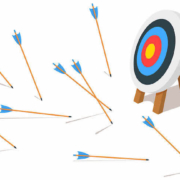Senior Living Leads: 5 of the Biggest Lead Scoring Mistakes to Avoid
Some visitors to your senior living community website will be in the early stages of their buying journey. Others will be much farther down the sales funnel, giving indications of being “sales qualified,” even though they haven’t reached out to schedule a tour yet.
So, how can you tell the difference? How can you know who’s a marketing-qualified lead vs. a sales-qualified lead? That’s precisely where lead scoring comes into play.
We asked Paul Trusik, our Director of Operational Technology, to share his insights about lead scoring, including how to avoid five of the biggest mistakes he consistently sees communities making.
What is lead scoring, and why should senior living communities implement it?
The goal of lead scoring is simple: to help marketing and sales teams prioritize their website leads by creating a straightforward way to identify which leads are “high intent” and ready for a sales follow-up and which ones need more nurturing.
Even if a site visitor hasn’t directly requested a tour or a sales interaction, their actions might suggest they are sales-ready. For example, maybe the lead is opening every email you send them. Maybe they’re consuming multiple blog posts at once. Maybe they’re interacting with social media posts or clicking on paid ad campaigns. Maybe they indicated on a form that they want to move into senior living within 90 days.
Unlike the websites of two decades ago, we now have tools that provide this level of intelligence on the people who visit your site. With platforms like HubSpot and ActiveDEMAND, we can see exactly where a site visitor is in their journey. We can follow a person as they navigate through your site. We know which calls-to-action they click on. We can see which blog posts they’re reading. We can ask them specific questions on the forms they fill out.
Armed with this intel, we can apply points to different actions and answers. Over time, the numbers accumulate into a score. Once the score passes a specific threshold indicating sales readiness, we can send that lead to the sales team for follow-up.
And by “we,” we mean the marketing automation that is seamlessly doing the work in the background.
If you want to dive deeper, HubSpot has this tutorial on lead scoring. Plus, check out this explainer video, which also provides an excellent visual explanation of how lead scoring works—and how it keeps improving thanks to AI and machine learning.
How does Senior Living SMART develop lead-scoring parameters for its clients?
Our tech team has developed baseline lead-scoring parameters to use as a starting point. From there, we review the parameters with the client so they can provide feedback. We then customize the lead scoring parameters based on this feedback.
For example, the client might say, “You know what? It’s great that people are opening our newsletters, but let’s not put that high on the priority list. Let’s score that a little bit lower, because, from our experience, these people are still at the top of the sales funnel. They won’t decide any time soon, but it’s good that they’re engaged. Over time, we can nurture them.”
Or, they might point out to us a piece of content that tends to result in people booking tours—so we’d score that higher.
What are some of the biggest mistakes that communities make with their senior living lead scoring?
We regularly encounter the following mistakes:
Mistake #1: Not having enough good content and lead magnets.
You need great content on your website for people to interact with—and a variety of content that satisfies people at every stage of their journey. You must put out fresh content regularly as well. The more content you offer, the more reasons people have to return to your website.
You also need good third-party lead magnets, like live chat, surveys, call tracking, or other interactive elements that help engage people and create a “sticky” site. We can grade those pieces as part of the lead-scoring attributes we compile.
So, the more content and lead magnets you have, the more powerful your lead scoring will be.
Mistake #2: Not having enough referral sources contributing traffic to your site.
People land on websites via multiple ways, such as organic search and referral traffic from third parties, like social media sites or directory listings. All of those pieces are trackable. For example, if someone clicks on a pay-per-click (PPC) ad, we can include the action in lead scoring.
Here’s where the magic comes into play.
Let’s say you’re running a PPC campaign. People click the ad, but when they visit your site, they’re not converting into tour requests as you had hoped. This is often the biggest gripe from marketing and sales teams about PPC campaigns: “We’re running PPC, but we’re not getting any leads! What gives?”
Here’s the thing: Some people who click on the PPC ad might still be at the top of the funnel. But others might indeed be “high intent,” even though they haven’t requested a tour yet. Through lead scoring, we can identify the high-intent leads and serve them to the sales team for follow-up.
Bottom line: If your site doesn’t receive enough organic traffic, running paid campaigns can be a great way to get people to your site so that we can learn about them, score them, and send the high-intent leads to sales while we continue nurturing the ones that aren’t quite ready yet.
We can even score people who come in from more traditional marketing campaigns like direct mailers or print ads, thanks to QR codes which is a trackable element.
Mistake #3: Setting it and forgetting it.
We all love it when something is “set it and forget it.” But lead scoring isn’t one of those things. You must regularly revisit your lead scoring and refine it as needed.
This isn’t just a problem plaguing senior living marketing and sales teams, either. Some agencies can fall victim to the “set it and forget it” mentality. (We know because we’ve inherited some big messes over the years!)
Pro tip: Revisit your lead scoring quarterly, because here’s the thing: Campaigns change. Or new paid ads come into play. Or fresh content is published on the site. It makes sense to revisit your lead scoring and say, “Okay, we set this up three months ago. What’s changed? Maybe there are additions to the website we didn’t consider the first time around.”
You should also seek feedback from your sales team—they’re the boots on the ground and can provide valuable insights on lead quality.
Mistake #4: Yielding to sales pressure.
Sales teams are famous for complaining that they don’t have enough leads, but marketing teams should resist lowering lead scoring thresholds simply to shut them up.
Lowering the lead scoring threshold means you’ll be serving up more leads, not better leads. Many of the leads won’t be ready for a sales call. The sales team will end up spinning its wheels (and possibly alienating prospects turned off by the intrusion).
You must strive to maintain a balance between quantity and quality. While it’s important to keep the sales team happy and well-fed with leads, it’s equally crucial to ensure that the leads you do serve up have indicated their sales readiness based on their actions.
We spend a lot of time educating clients about this—and empowering marketing teams to withstand pressures from sales.
Mistake #5: Ignoring “negative” actions that can influence lead scores.
Just as there can be positive lead scoring, you can also include negative scores. For example, a salesperson could say, “Hey, we’ve talked to this lead before. They are financially or medically unqualified.” We can use that information as negative scoring and include that in the algorithm so the sales team doesn’t see that lead come through again.
The same goes for other actions on the website. Not everyone visiting your site is looking for a senior living community. Vendors and prospective employees will be looking as well. We can include these “negatives” in the lead scoring.
For example, we could assign negative point values if the person inquires about careers or is already in the senior living CRM and has been marked as unqualified. (Note: The latter requires bilateral integration between your marketing automation and CRM. We’re big fans of WelcomeHome CRM because of its ability to do this.)
Including negatives in the overall lead score is a powerful way to ensure that your sales team isn’t wasting valuable time on leads that aren’t going to convert. You create a more nuanced and accurate lead-scoring process by factoring in positive and negative indicators.
How do you know if your senior living lead scoring is effective?
Remember, the key to knowing if your lead scoring is hitting the mark lies in feedback from your sales team. They can share insights regarding lead quality. We can also set up reports to track leads from scoring to contact, pre-tour to post-tour, and deposit to move-in. This can provide tangible evidence of lead-scoring success.
Need help with your lead scoring?
Our marketing agency focuses only on senior living. We know how to help communities attract and convert better senior living leads. Get in touch with our teams, and let’s talk.











